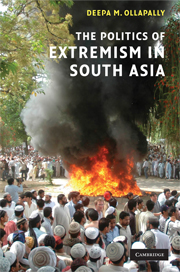Book contents
- Frontmatter
- Contents
- Acknowledgements
- Map of South Asia
- 1 Introduction: beyond and before the 9/11 framework
- 2 Situating violent conflict in South Asia
- 3 Afghanistan's changing fortunes
- 4 Pakistan at the crossroads
- 5 Conflict and contradiction in Kashmir
- 6 Sri Lanka's violent spiral
- 7 Bangladesh: divided politics and geopolitics
- 8 Conclusion
- Bibliography
- Index
2 - Situating violent conflict in South Asia
Published online by Cambridge University Press: 05 September 2012
- Frontmatter
- Contents
- Acknowledgements
- Map of South Asia
- 1 Introduction: beyond and before the 9/11 framework
- 2 Situating violent conflict in South Asia
- 3 Afghanistan's changing fortunes
- 4 Pakistan at the crossroads
- 5 Conflict and contradiction in Kashmir
- 6 Sri Lanka's violent spiral
- 7 Bangladesh: divided politics and geopolitics
- 8 Conclusion
- Bibliography
- Index
Summary
From margin to epicenter: Locations and dislocations
In his testimony before the Senate Foreign Relations Committee's Subcommittee on Near Eastern and South Asian Affairs on November 2, 1999, Ambassador Michael Sheehan, Coordinator for Counterterrorism in the US, concluded that “The center of anti-American terrorism has moved from the Middle East to South Asia … As direct involvement in terrorism by most Middle Eastern state sponsors and groups has declined, our attention has increasingly focused on Osama bin Laden and the alliance of groups operating out of Afghanistan with the acquiescence of the country's de facto rulers, the Taliban.” When viewed from a historical standpoint, however, South Asia's new status presents a serious anomaly.
Chapter One noted the major gaps and analytical shortcomings in ethno-religious explanatory frameworks for violent extremism in the region. This chapter will take a substantive look at a broad sweep of South Asian history to suggest that it is difficult to find any historically deterministic trend in ethno-religious extremism. It would be a mistake to take the current period as the touchstone and project backwards as many seem to do. The need for historical analysis becomes clear when we consider how many observers of South Asian politics and geopolitics either ignore, or do not understand, critical historical aspects. This chapter will provide context to the contention that, although violence in South Asia is certainly not a modern phenomenon, the fault lines along which violence occurred in the past cannot be reduced to religion or ethnicity.
- Type
- Chapter
- Information
- The Politics of Extremism in South Asia , pp. 22 - 52Publisher: Cambridge University PressPrint publication year: 2008



